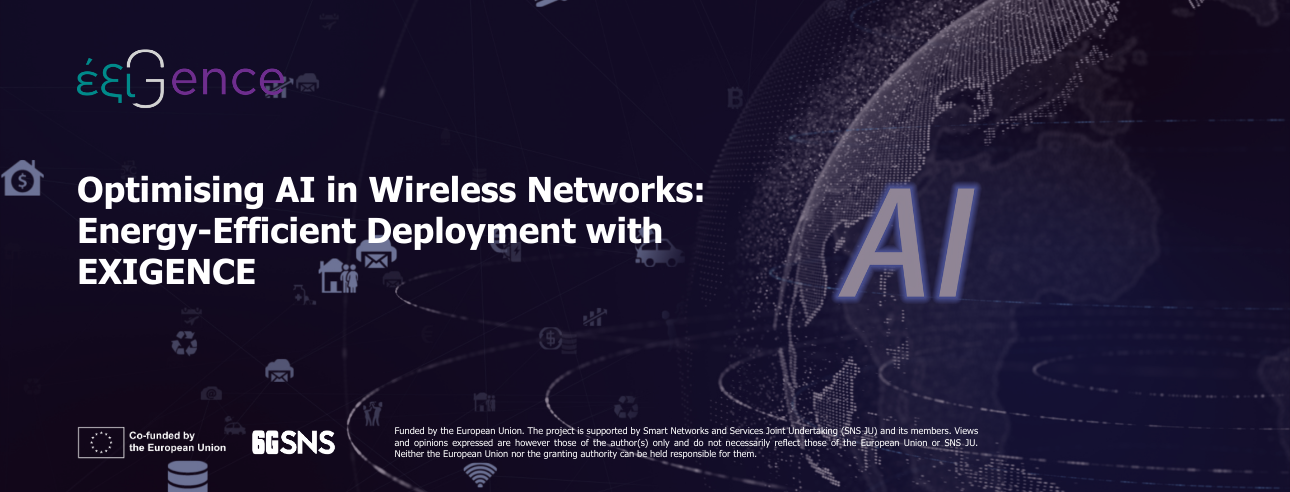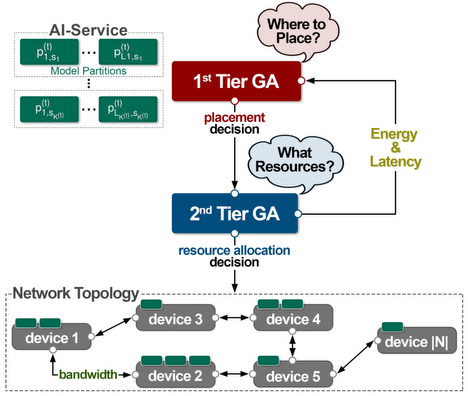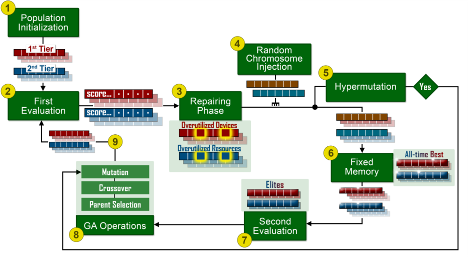
As the world transitions into an era dominated by Artificial Intelligence (AI), wireless networks are evolving to become more intelligent, automated, and responsive. AI-enabled networks promise significant improvements in scalability, adaptability, and real-time decision-making. Yet, the deployment of distributed AI systems comes with increasing energy demands, challenging sustainability goals and operational efficiency.
The EXIGENCE project addresses these challenges head-on, focusing on energy-efficient AI-powered wireless networks. By combining cutting-edge algorithms, innovative resource orchestration, and research-driven experimentation, EXIGENCE is advancing a vision of networks that are not only smarter but also sustainable and aligned with Europe’s energy-conscious future.
This blog post explores one of the key technical innovations developed within EXIGENCE – a two-tier hierarchical genetic algorithm (HGA) – and how NKUA contributes to spreading the project’s core values through research and academic engagement.
The Challenge: Energy Efficiency in Distributed AI Networks
Distributed AI is transforming wireless networks, enabling them to adapt dynamically to traffic, user demand, and environmental conditions. AI models are often split across multiple network nodes, allowing faster decision-making and localised intelligence. However, distributing intelligence in this way is resource-intensive, requiring significant computational power, memory, and network bandwidth.
Traditional methods for resource allocation and network orchestration often fail to fully optimise energy usage, especially in large-scale deployments where AI services are distributed across dozens or hundreds of nodes. Without innovative strategies, energy inefficiencies can grow exponentially, threatening both performance and sustainability.
EXIGENCE seeks to resolve this tension by developing energy-conscious distributed AI solutions that maintain network responsiveness while reducing operational costs and environmental impact.
The Solution: Hierarchical Genetic Algorithm (HGA)
To minimise energy consumption while maintaining performance, EXIGENCE researchers have developed a meta-heuristic two-tier hierarchical genetic algorithm (HGA). This approach applies a divide-and-conquer strategy, enabling chained decision-making across network layers. An overview is presented in the figure below.

Figure 1: Illustration showing AI distribution across the wireless network.
Tier 1: Optimal Model Partition Placement
The first tier identifies the most efficient placement of AI model partitions across the network infrastructure. By strategically allocating computational tasks to nodes with optimal energy efficiency and connectivity, the HGA ensures that resource utilisation is minimised without compromising performance.
Tier 2: Resource Allocation for Partitions
The second tier focuses on allocating specific network resources – bandwidth, memory, and computation – to each partition. This tier guarantees that latency requirements are met while further reducing energy consumption.
Safe Strategy Selection
The algorithm incorporates a custom repair mechanism and penalty function to avoid constraint violations, ensuring that energy, latency, and operational limits are respected. The methodology is shown in the figure diagram, with visualization that helps understanding the step-by-step workflow of the HGA, showing how energy efficiency and latency constraints are balanced in real time.

Figure 2: Diagram illustrating the two-tier hierarchical genetic algorithm, including model partition placement, resource allocation, and safe strategy selection.
The HGA has been rigorously evaluated against two state-of-the-art baseline solutions across various network environments and traffic scenarios. Results show that:
- Energy consumption is significantly reduced compared to traditional allocation methods.
- Service latency remains within required thresholds, ensuring smooth operation.
- The algorithm demonstrates robustness and adaptability, efficiently handling dynamic network conditions.
This demonstrates that the HGA is not only a technical solution but also a concrete step toward energy-efficient AI networks, directly supporting the core values of sustainability, innovation, and responsible resource management. For more details refer to the next figure.
Beyond algorithmic innovation, EXIGENCE places a strong emphasis on dissemination, academic engagement, and knowledge transfer. NKUA contributes to this mission by providing a variety of MSc thesis opportunities that explore different aspects of energy efficiency in AI-enabled wireless networks.
These research projects are tightly integrated into the EXIGENCE framework, ensuring that students’ work directly supports the project’s vision of sustainable, energy-conscious AI networks. Examples include:
- Optimising 5G networks with Open5GS and PowerAPI to monitor and manage energy consumption in real-time.
- Combining PowerAPI, Scafandre, and the Elastic Stack (Prometheus and Grafana) to create detailed energy and performance dashboards.
- Exploring Permissioned Distributed Ledgers (PDL) to improve security, transparency, and trust in network operations.
Through these MSc theses, students contribute not only to advancing technical knowledge but also to promoting the core values of EXIGENCE – energy efficiency, sustainable innovation, and responsible research practices. This effort ensures that the project’s vision is disseminated widely, cultivating the next generation of engineers and researchers who will carry forward these principles.
Conclusion
The EXIGENCE project exemplifies how innovation, sustainability, and academic engagement can work together to shape the future of AI-enabled wireless networks. The hierarchical genetic algorithm demonstrates a practical and scalable solution for reducing energy consumption in distributed AI systems.
At the same time, NKUA’s MSc thesis program ensures that these advances are not only implemented but also widely disseminated, fostering a culture of sustainable, energy-efficient research and innovation. Together, these efforts highlight how technical excellence and knowledge-sharing can drive real-world impact, enabling smarter, greener, and more responsible wireless networks for the future.
Authors

National and Kapodistrian University of Athens
Lina Magoula is currently a Senior PhD candidate and is working as Technical Manager at the SCAN Laboratory of National and Kapodistrian University of Athens, performing active research in applied AI for next generation networks. Since 2021, she has been working as Technical Manager of the SCAN laboratory, actively involved in the design and development of AI-empowered solutions for intelligent resource orchestration for 5G+ networks. Her main areas of interest are Machine Learning, Artificial Intelligence, 5G and Beyond Networks, Distributed Learning, Green Communications, Smart Resource Orchestration and Network Function Virtualisation.

National and Kapodistrian University of Athens
Nikolaos Koursioumpas is a Senior PhD Candidate and works as Technical Project Manager at the SCAN Laboratory of National and Kapodistrian University of Athens. He received his B.Sc and M.Sc from the Department of Informatics and Telecommunications with specialisation in “Computer Networking and Telecommunications”. He is distinguished for his strong background in the design and development of distributed AI/ML algorithms for dynamic resource allocation through Context and Energy-Aware Resource Management. His main areas of interest include: Distributed AI, Green 5G+ and 6G Networks

National and Kapodistrian University of Athens
Mr. Panagiotis Kontopoulos obtained his four-year Bachelor of Science (B.Sc.) and two-year Master of Science (M.Sc.) from National and Kapodistrian University of Athens (UoA), in the Department of Informatics and Telecommunications. Currently works as a Research Associate in the Software Centric & Autonomic Networking (SCAN) Lab of UoA in conjunction with his Doctor of Philosophy (PhD) from National and Kapodistrian University of Athens (UoA), in the Department of Informatics and Telecommunications, with a specialisation in Artificial Intelligence, Telecommunications and Networks. His main fields of interest are Software-Defined Networking (SDN), Software-Defined Wireless Local Area Networking (SDWLAN), distributed systems, mobile communication systems and services in future networks.

National and Kapodistrian University of Athens
Theodora Panagea is currently pursuing her Masters Degree at the Department of Informatics and Telecommunications, National and Kapodistrian University of Athens (NKUA). She received her Bachelor of Science (B.Sc.) from the same department, with a specialisation in “Computer Science Foundations”. She is currently working as a Research Associate at the Software Centric and Autonomic Networking (SCAN) Laboratory at NKUA. Her main topics of interest are machine learning, artificial intelligence, algorithms, and cognitive science.
